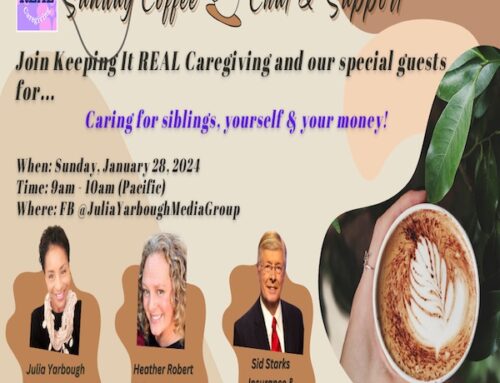Exclusive OPINION ESSAY: Roe v Wade, abortion and aging

Exclusive Opinion Essay
Keeping It REAL Caregiving is a non-political platform.
The goal is to provide family caregivers with news, information, guidance and insight from those who have lived the journey and can offer assistance.
Often there are current events that may seem as though they have nothing to do with aging and family caregiving. But if you step back and take a broader view, you just might see how the issues are more connected than you have realized.
Roe v. Wade and the Supreme Court
Case in point: the heated national conversation over the possibility the U.S. Supreme Court could overturn the landmark 1973 Roe v. Wade decision, making abortion legal for women in the United States.
For the past week, I’ve been watching news reports of what might happen.
What are the further implications of such a decision for women and women’s health?
In what states are abortions currently legal for women making that choice?
Which states have recently passed laws banning or severely restricting a woman’s right to choose?
Which state legislatures have recently enacted ‘trigger-laws,’ which, if Roe v. Wade is overturned, would immediately take effect and how severe are some laws now being considered?
What does it all mean?
Clearly, those on both sides of the issue are now in a holding pattern, awaiting the Supreme Court’s decision.
This opinion essay is not so much about choosing sides on the debate, but rather, to offer up a viewpoint for deeper consideration.
Life begins at conception
For those who come at this issue from the assumption that life begins at conception, the very idea of a woman making the individual and personal choice to have an abortion is morally wrong -or even a crime to be punished.
Government should not control women’s reproductive rights
For those who support a woman’s right to make choices for her own body, and the health and well-being of her family, to allow a state legislative body (despite progress most are still dominated by older white men), to determine personal health choices is incomprehensible.
Many would argue, if the government should not be involved in other personal decisions in our lives, why should this women’s health arena now be dictated by so many others who have nothing to do with any given individual woman’s choice?
Taking a broader view
As I watched the news reports of demonstrations around the country and viewed maps showing which states take which position, I began to wonder how this issue might be framed if we were to consider it in relation to state policies and programs regarding aging?
I believe we must ask ourselves and our legislators these questions:
Do those fighting for the sanctity of life carry that fire all the way through the life span?
How many state lawmakers pushing for policies to remove abortion access and even punish women who make that choice, also advocate just as fiercely for life at the other end of the spectrum- for our elders?
Exhibit A: This map shows the states where abortions are legal and those states where legislatures are working hard to control women’s reproductive rights.

Courtesy: The Pew Charitble Trusts @2022
Exhibit B: This map shows which states have implemented a Master Plan for Aging (or similar policies) and are taking bold steps to address the needs of their aging populations in terms of medical care, housing, transportation, connectivity, caregiving services, education, insurance and workplace awareness.
Right now, just five (5) states have made this move.
Keep in mind, that our population is rapidly aging and these issues impact people across all demographics: socio-economic, racial, cultural, urban/rural, religious and ethnic.

Courtesy:
Take a good look at these maps. Compare them. Look at which states are focused more on only the beginning of life. Look at which states are also seriously thinking about what aging and end-of-life means for families and communities.
I can’t help asking the question: Given the focus on protecting life and restricting a woman’s legal right to an abortion (with some states denying it even in the case of rape or incest), at what point — and age — does that drive to protect life end?
Does it stop at age 6?
Does it stop at 18?
Does it stop at 35?
Does it stop at 55?
Does it no longer matter past age 65?
And do we even remember the importance of protecting life once we’re talking about age 85 and beyond.
It seems to me that if states are so determined to ‘protect life,’ then policies, funding, programs and commitment to ‘life’ must be put in place to care for life at all stages — not just those recently conceived — but throughout the entire life span, until the every end.
What are your thoughts on this “conception – life span – death” connection?

I’m curious if anyone else is looking at this issue from both ends of the age spectrum.
Until next time~
Julia
*Header Image: RENO, NEVADA, UNITED STATES – 2022/05/07: A protester holds a placard up that says “Reproductive rights = Human rights”. Protestors gathered to voice their anger at the leaked Supreme Court documents. (Photo by Ty O’Neil/SOPA Images/LightRocket via Getty Images)





Like our content? We invite you to leave a comment and say hello!